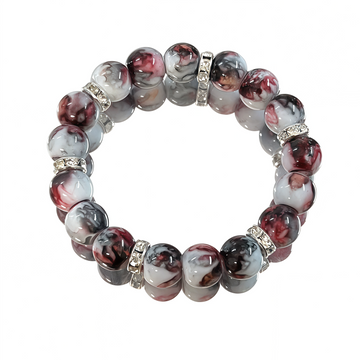Regular Inspection Guidelines and Frequency for Stone Bracelets
Stone bracelets, whether adorned with gemstones, crystals, or semi-precious materials, require routine maintenance to ensure their longevity, safety, and aesthetic appeal. Regular inspections help identify wear, damage, or loose components before they escalate into costly repairs or safety hazards. Below is a comprehensive guide to inspection content and recommended cycles.
Visual and Structural Examination
The first step in maintaining a stone bracelet involves a thorough visual and structural assessment.
Stone Integrity
- Cracks or Chips: Inspect each stone for visible fractures, which can weaken the structure and lead to breakage. Pay close attention to edges and corners, as these areas are prone to impact damage.
- Loose Settings: Gently tap the bracelet or use a loupe to check if stones wobble in their settings. Loose stones may fall out during wear, resulting in loss or further damage.
- Discoloration or Cloudiness: Some stones may fade, darken, or develop a hazy appearance over time due to exposure to light, chemicals, or heat. Document any changes for future reference.
Metalwork and Clasps
- Metal Fatigue: Examine the metal band or links for signs of bending, stretching, or thinning. Weakened metal can snap under pressure, especially in delicate designs.
- Clasp Functionality: Test the clasp repeatedly to ensure it opens and closes smoothly. A faulty clasp increases the risk of losing the bracelet.
- Tarnish or Corrosion: Look for discoloration on metal surfaces, which may indicate oxidation or exposure to moisture. Tarnish not only affects appearance but can also weaken the metal over time.
Wear and Tear Assessment
Daily use subjects stone bracelets to friction, impacts, and environmental factors. Regularly evaluating wear patterns helps prevent irreversible damage.
Surface Abrasions
- Scratches on Stones: Even hard stones like sapphire or ruby can scratch if exposed to rough surfaces. Use a soft cloth to buff minor scratches, but deep gouges may require professional repolishing.
- Metal Scuffing: Check for scratches or dents on the metal band, especially in areas that rub against clothing or other jewelry. Polishing can restore shine, but excessive wear may necessitate resizing or replacement.
Prong and Bezel Security
- Prong Condition: For prong-set stones, verify that prongs are intact and not bent or lifted. Bent prongs can snag on fabrics or catch on objects, loosening the stone.
- Bezel Adhesion: In bezel-set designs, ensure the metal rim fully encases the stone. Gaps or loose bezels expose stones to impact and moisture, increasing the risk of damage.
Elastic or Cord Durability (If Applicable)
- Stretch Elastic: For bracelets with elastic bands, test the stretchiness by gently pulling. Over time, elastic can lose elasticity or fray, leading to breakage.
- Cord Integrity: Bracelets strung on silk, nylon, or leather cords should be checked for fraying, discoloration, or weakening. Restringing may be needed if the cord shows signs of deterioration.
Recommended Inspection Cycles
The frequency of inspections depends on how often the bracelet is worn and the conditions it’s exposed to.
Daily Wear Bracelets
- Monthly Checks: For bracelets worn daily, perform a quick visual inspection monthly. Focus on the clasp, stones, and any areas that rub against skin or clothing.
- Professional Cleaning: Schedule a deep cleaning and inspection every 6–12 months. A jeweler can use ultrasonic cleaners or steam to remove hidden dirt and assess structural integrity.
Occasional Wear Bracelets
- Quarterly Reviews: Bracelets worn a few times a month should be inspected every 3 months. Pay attention to storage conditions, as humidity or dust can accelerate tarnish or stone degradation.
- Pre-Wear Check: Before wearing a stored bracelet, inspect it for any changes since the last use. This prevents surprises like loose stones or stiff clasps.
Special Occasion Bracelets
- Annual Assessments: For heirloom or delicate pieces worn infrequently, a yearly inspection suffices. Store them in airtight containers with anti-tarnish strips to minimize oxidation.
- Post-Event Check: After wearing a bracelet to a special event, inspect it for damage caused by handling, perfumes, or lotions. Clean it gently to remove residue.
Environmental and Storage Considerations
Beyond regular inspections, proper storage and care extend the life of stone bracelets.
Storage Conditions
- Avoid Humidity: Store bracelets in a dry, cool place to prevent tarnish and mold. Silica gel packets can absorb excess moisture.
- Separate Storage: Keep bracelets in individual pouches or compartments to prevent scratching from contact with other jewelry.
Handling Precautions
- Remove Before Activities: Encourage users to take off bracelets before swimming, exercising, or gardening to avoid exposure to chemicals, sweat, or physical impacts.
- Clean After Use: Wipe bracelets with a soft, lint-free cloth after wearing to remove oils, lotions, or dirt.
Conclusion
Regular inspections are vital for preserving the beauty and functionality of stone bracelets. By adhering to a structured inspection schedule and addressing issues promptly, owners can enjoy their jewelry for years to come. Whether worn daily or reserved for special occasions, proactive care ensures that stone bracelets remain both safe and stunning.







